

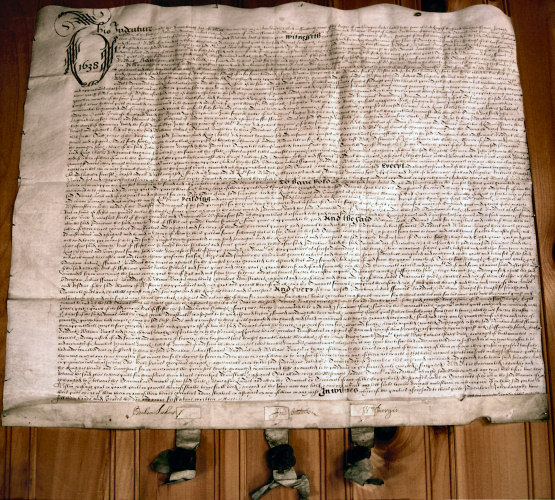
![]() There are many times that we say things ~ words or phrases ~ that we don't realize had special or particular meanings to our ancestors. One such phrase is "signed, sealed and delivered". We say it when we have finished something, simply to mean that it is complete ~ that we don't intend to add to it. We often don't even consider that at one time the phrase actually meant that something had been signed, then sealed and then delivered.
There are many times that we say things ~ words or phrases ~ that we don't realize had special or particular meanings to our ancestors. One such phrase is "signed, sealed and delivered". We say it when we have finished something, simply to mean that it is complete ~ that we don't intend to add to it. We often don't even consider that at one time the phrase actually meant that something had been signed, then sealed and then delivered.
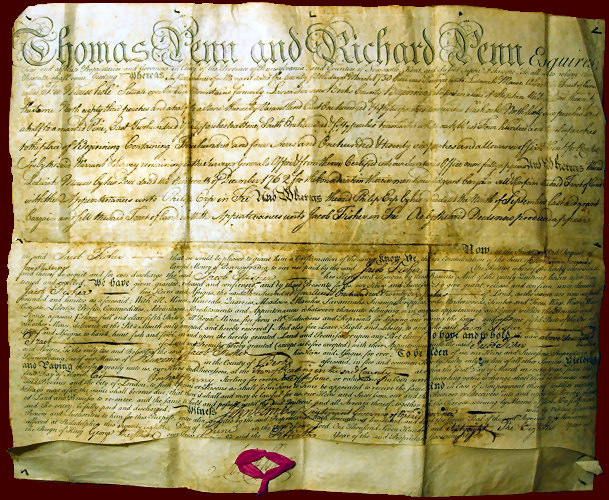
![]() In the early 18th Century, a deed was "an instrument written on paper or parchment, consisting of three things, viz. Writing, sealing and delivery; and comprehending a contract, or bargain between party and party." That's the definition from a book published in London in 1741 ~ Cyclopaedia: Or An Universal Dictionary Of Arts And Sciences.
In the early 18th Century, a deed was "an instrument written on paper or parchment, consisting of three things, viz. Writing, sealing and delivery; and comprehending a contract, or bargain between party and party." That's the definition from a book published in London in 1741 ~ Cyclopaedia: Or An Universal Dictionary Of Arts And Sciences.
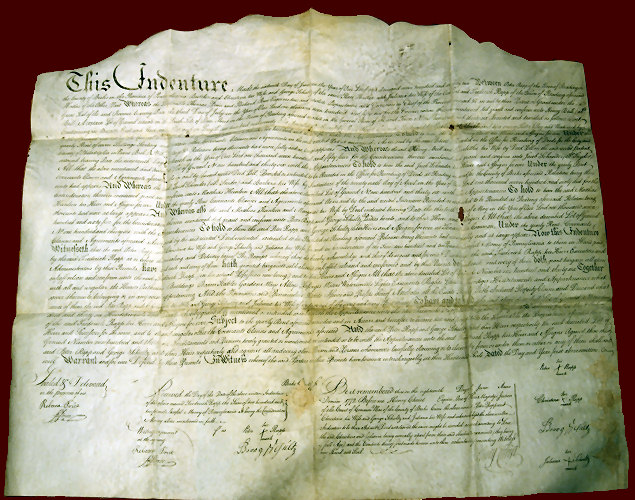
![]() A simple deed, such as a Last Will And Testament, in which one person (or party, as in "the party of the first part") gave property (real or personal) to a second person (or party, as in "the party of the second part"), retained that simple name: a deed.
A simple deed, such as a Last Will And Testament, in which one person (or party, as in "the party of the first part") gave property (real or personal) to a second person (or party, as in "the party of the second part"), retained that simple name: a deed.
![]() When there were more than one persons involved, where one person (or party) gave property (real or personal) to a second person (or party), and the second person reciprocated in some way, such as by paying money to receive the property, the deed was given a different name: an indenture. It was called an indenture, because the various sections of the document (one for the giver and one for the receiver) each had the first word of their part indented, so as to easily be found when the document was read. Each person, or party, involved in the deed or indenture would sign the document, usually along the bottom edge.
When there were more than one persons involved, where one person (or party) gave property (real or personal) to a second person (or party), and the second person reciprocated in some way, such as by paying money to receive the property, the deed was given a different name: an indenture. It was called an indenture, because the various sections of the document (one for the giver and one for the receiver) each had the first word of their part indented, so as to easily be found when the document was read. Each person, or party, involved in the deed or indenture would sign the document, usually along the bottom edge.
![]() The transaction, whether a simple deed or a multi-party indenture, was not complete in the writing of it on the paper or parchment (and thusly being signed). In fact, it was only one third completed at that point. It still had to be sealed and delivered. And if those two steps were not completed, the transaction, in the sight of the law, did not exist.
The transaction, whether a simple deed or a multi-party indenture, was not complete in the writing of it on the paper or parchment (and thusly being signed). In fact, it was only one third completed at that point. It still had to be sealed and delivered. And if those two steps were not completed, the transaction, in the sight of the law, did not exist.

![]() Again, according to the 1741 Cyclopaedia: "Sealing deeds, makes persons parties to them: and if they are not thus sealed they are void. If a Seal is broken off, it will make the deed void; and when several are bound in a bond, the pulling off the Seal of one makes it void as to the others..." The seal was a small ball of clay that was formed around the paired ends of a thin strip of parchment that had been woven through a slit in the document's bottom edge. The ball of clay, when it was still damp and pliable, would have a relief design pressed into it, usually from a signet ring possessed by the person creating the deed (i.e. the party of the first part). Individuals who did not own a signet ring, usually owned a small metal object intended for the purpose of sealing documents. That object was called a seal or a seal die. In some cases, such as the large clay seal shown on the document, dated 1638, above, the seal entirely encloses the thin strip of parchment, whereas the seal shown on the document, dated 1770, below, simply sits on the surface of the parchment strip. The latter one might not even consist of clay; wax tended to be used because it was more easily obtained and used.
Again, according to the 1741 Cyclopaedia: "Sealing deeds, makes persons parties to them: and if they are not thus sealed they are void. If a Seal is broken off, it will make the deed void; and when several are bound in a bond, the pulling off the Seal of one makes it void as to the others..." The seal was a small ball of clay that was formed around the paired ends of a thin strip of parchment that had been woven through a slit in the document's bottom edge. The ball of clay, when it was still damp and pliable, would have a relief design pressed into it, usually from a signet ring possessed by the person creating the deed (i.e. the party of the first part). Individuals who did not own a signet ring, usually owned a small metal object intended for the purpose of sealing documents. That object was called a seal or a seal die. In some cases, such as the large clay seal shown on the document, dated 1638, above, the seal entirely encloses the thin strip of parchment, whereas the seal shown on the document, dated 1770, below, simply sits on the surface of the parchment strip. The latter one might not even consist of clay; wax tended to be used because it was more easily obtained and used.
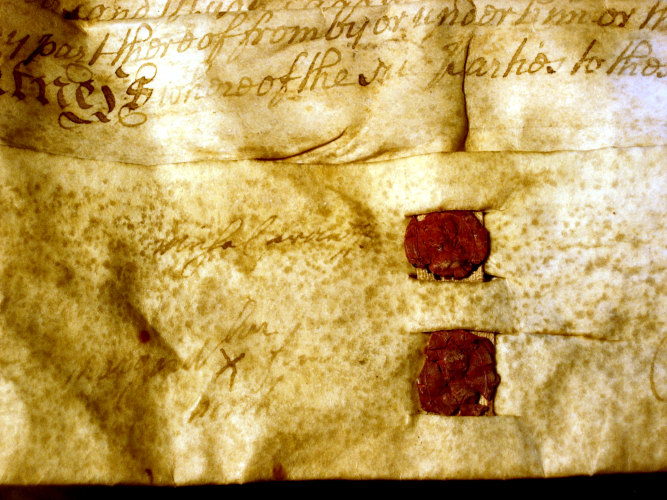
![]() The wax seal would harden like the clay one, retaining the relief design pressed into it by either a signet ring or a seal die. Some deeds were sealed by weaving a piece of silk ribbon through the parchment, as in the example dated 1762 and signed by John Penn, shown below, in which the ribbon is sewn over the signature in order to 'seal' it in.
The wax seal would harden like the clay one, retaining the relief design pressed into it by either a signet ring or a seal die. Some deeds were sealed by weaving a piece of silk ribbon through the parchment, as in the example dated 1762 and signed by John Penn, shown below, in which the ribbon is sewn over the signature in order to 'seal' it in.
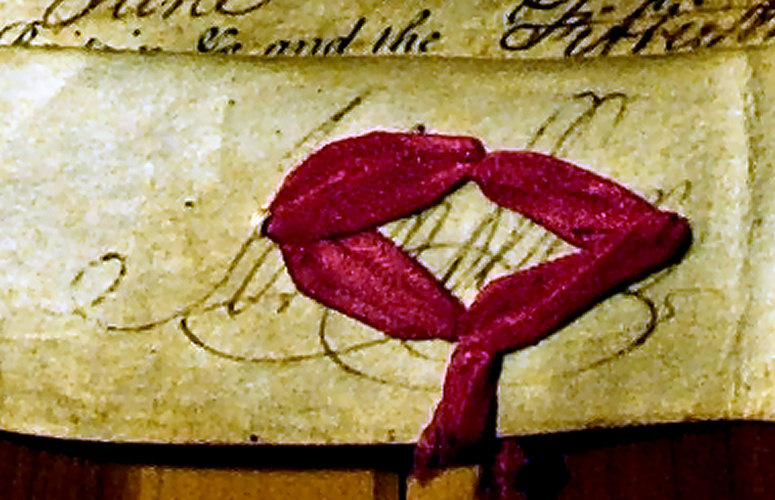
![]() The third part of the process involved the physical delivery of the document to the second person (or party). In the case of a Last Will And Testament, the document might not be delivered to the second person until the first person actually died. On the other hand, an indenture, being a transaction of property between two persons, would probably be signed and sealed by both parties at the same time, and therefore the document could be delivered to the second person (or party) immediately.
The third part of the process involved the physical delivery of the document to the second person (or party). In the case of a Last Will And Testament, the document might not be delivered to the second person until the first person actually died. On the other hand, an indenture, being a transaction of property between two persons, would probably be signed and sealed by both parties at the same time, and therefore the document could be delivered to the second person (or party) immediately.
![]() So, there were three parts to the transference of property known as a deed, which had to exist in order to make the transaction valid and lawful: it had to be signed, sealed and then delivered. If it had all three parts, it was considered complete. That is why today we signify something that is complete by saying it is "signed, sealed and delivered."
So, there were three parts to the transference of property known as a deed, which had to exist in order to make the transaction valid and lawful: it had to be signed, sealed and then delivered. If it had all three parts, it was considered complete. That is why today we signify something that is complete by saying it is "signed, sealed and delivered."
